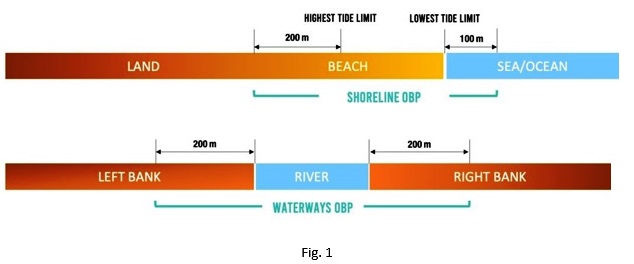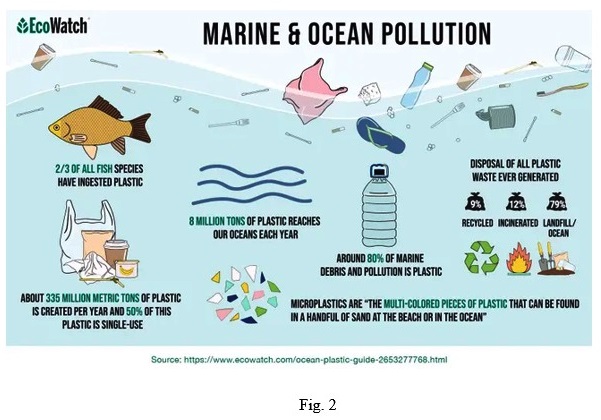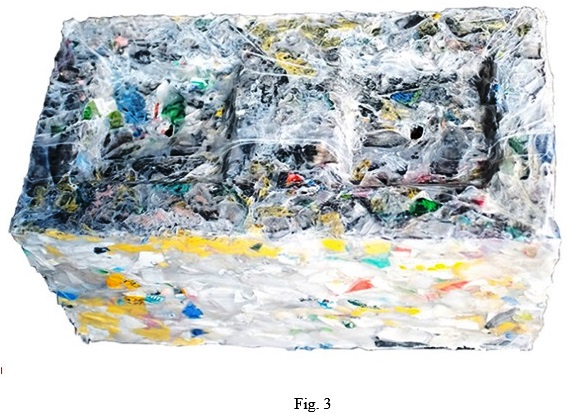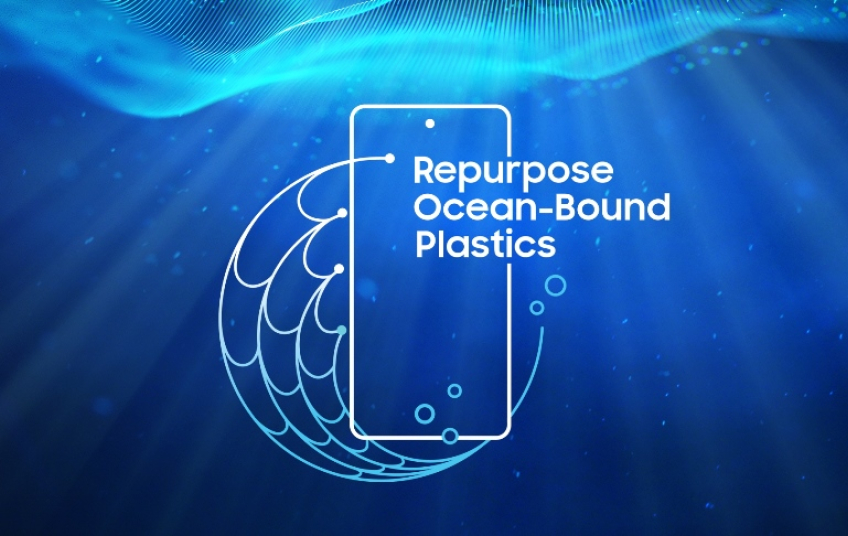Ocean Plastics
Ocean Bound Plastic is the term that Jenna Jambeck, Ph.D., would make popular back in 2015 as a professor at the University of Georgia. This is plastic waste that has not been collected correctly and is abandoned in the environment where it will be transported to the ocean by wind, rain, river, floods, or tides. The sources of how they get into the ocean can be broken down into three subtopics: waterways, shoreline, and fishing material ocean-bound plastic in Fig. 1. “Waterways Ocean Bound Plastic: Abandoned Plastic Waste located within a distance of 200m from both sides of the river stream” (OBPCERT, 2021). The waterway category goes farther than the 50 km for shore distance because rivers can carry macro or micro-plastics to the oceans from way more than 50 km. “Shoreline Ocean Bound Plastic: Abandoned Plastic Waste located within 200m from the highest tide line towards land and 100m from the lowest tide line towards the sea” (OBPCERT, 2021). The shoreline category explains that plastics can be brought in from 200m on land, the highest tide limit. “Fishing Material Ocean Bound Plastic: This category covers all the plastic waste generated by fishermen and the plastic bycatch when taken by projects offering an incentive to fishermen to bring back this plastic at shore” (OBPCERT, 2021). The fishing material category is mostly fishing gear that gets caught on ocean life or gets thrown back into the ocean. Fishing gear is the deadliest to marine life, coral, sessile animals, and vegetation. “Ghost Gear” is abandoned fishing gear that can potentially trap marine life. This makes up about 10 % of the ocean plastic pollution.

"Plastic debris can promote the spread of invasive organisms, further hurting marine ecosystems: floating plastics get carried out to sea through ocean currents" (Nakagawa, 2021). Ocean plastic has already affected many species (267 to be exact) and 86% of sea turtles. Sea turtles have been the face of improper waste disposal as they are affected the most, and the companies use the emotional aspect of tiny innocent sea turtles to spread awareness of ocean pollution. This does not only concern marine life's health, but it also concerns humans' health. Microplastics have been found in numerous foods and beverages, including water, beer, and salt. Over a lifetime, humans can consume around 44 pounds of microplastics. Most come from fish who eat these microplastics, thinking it is food. "Algalita researchers caught 672 fish, and 35% (around 235 fish) of the fish had eaten plastic pieces" (Nakagawa, 2021). As humans, we eat plastic without even knowing it.
The ocean makes up 71% of the Earth, and it is being polluted at an alarming rate. “8 million tons of plastic reaches our oceans to meet the 150 million metric tons of plastic that already exists in marine environments” (Nakagawa, 2021). This plastic primarily consists of everyday items such as wrappers, bottles, grocery bags, take-out containers, and plastic straws. These are categorized into microplastics. Microplastics are pieces of plastic that are smaller than five millimeters in length. Macroplastics are also a concern, bigger than 5 millimeters in length. However, most plastic pollution comes from large corporations, not households. These corporations must focus on their production processes, how their operation impacts the environment, and waste management. Currently, they focus on their production of single-use plastics by moving the responsibility of sustainable dumping onto the consumer. The soft drink industry single-handedly creates most of the plastic waste seen in oceans. Most bottles are littered along the street and taken through sewage systems, rivers, or creeks leading to the ocean from the cities inland. According to Nakagawa, 4 % to 8 % of global oil consumption is linked to plastics. Plastic is a petroleum product directly related to the fossil fuel industry. Extracting and transporting fossil fuels release carbon into the air, warming the planet even more. Ocean Plastics is not just a marine but also a climate issue.
Climate Change
Ocean plastics are a byproduct of fossil fuels and emit greenhouse gases that serve from cradle to grave. “Oil gas and coal are the fossil fuel building blocks of plastic” (Bauman, 2019). Extracting and transporting these fossil fuels is a carbon-intensive activity. It is reported that around 12.5 to 13.5 million metric tons of carbon dioxide is admitted per year extracting and transporting natural gas to create specifically feedstocks for plastics in the United States. About 40% of plastics are used as packaging. Packaging is regularly meant for a single use, so there is a quick turnaround for disposal. Packaging can be processed in three different ways: landfill, incineration, or recycling, as seen in Fig. 2. Plastic incineration is one of the leading causes of the emissions of carbon dioxide in the United States. If plastic production continues, the incineration in greenhouse gas emissions will increase to 49 million metric tons by 2030 and 91 million metric tons by 2050. Incineration facilities are also disproportionately built near communities where people live. The people who live in these communities are subjected to the pollution of these incinerators and are often the ones who are least responsible for the waste in the first place. Incinerator workers and people living near these facilities are significantly at risk of exposure to the thousands of pollutants released from burning waste. Even though landfilling has a much lower climate impact, Dennis generation, the placement of landfills can be associated with similar environmental issues. Recycling is the best option out of the three. However, it is rare to profit from recycling, so it requires considerable government subsidies. Recycling facilities commonly receive low-quality materials from people who think these materials are recyclable and are trying to make a difference but are not. Many Western countries, including the United States, have sent their contaminated waste to other countries, such as China, Thailand, Malaysia, and Vietnam. Still, these countries are starting to turn down the Western contaminated waste. Recycling will also not eliminate the plastic pollution crisis; too much plastic is being produced, so the Western world needs to address its addiction to single-use plastics. “Cutting emissions associated with plastics may require all of the above strategy: reducing waste, retaining materials by refurbishing or remanufacturing, and recycling” (Bauman, 2019).

Solutions
Fishing gear is one of the most prominent plastics in our ocean, continuously hurting marine life. A few options have been introduced to decrease the amount of fishing gear in the ocean. First is recycling old fishing material, where some ports offer recycling programs. Massachusetts, Oregon, and Rhode Island are the first few states to start this, and hopefully, it will gradually increase amongst all coastal states. Biodegradable fishing nets are currently on the rise. The net is made of polybutylene succinate and polybutylene adipate-co-terephthalate. Studies have shown that these biodegradable nets start to decompose after two years, instead of traditional l nets that never decompose. The last option is clean-ups. Organizations such as The Ghost Fishing Foundation specialize in recapturing abandoned nets from the ocean. The foundation periodically uses cranes to retrieve large pieces of netting. We, as humans, have done clean-ups for many other issues for many years. Volunteers continue to clean up the shoreline and other waterways, so having a foundation specializing in ocean clean-up is another step forward. Advanced technology is being developed to help contribute to some of the most significant ocean clean-up projects in history that are projected to happen soon. Currently, some organizations are teaching students the effects of plastic pollution and how they can contribute to ocean conservation. Training the next generation will help us in the future to preserve our earth and also our ocean. “Eliminating plastic waste directly at the source through proper waste management is often cited as the most viable route to ocean restoration” (Watt, 2021). Creating an integrated system with a focus on plastic lifecycle improvements can be sought out through government initiatives, consumer education, and infrastructure improvements.
The government has also taken its role in starting legislation laws to help protect the oceans and minimize plastic production and consumption. Eight states have banned single-use plastic bags, and hopefully, more in the upcoming years. “The Marine Debris Research, Prevention, and Reduction Act established programs in tandem with the National Oceanic and Atmospheric Administration and the United States Coast Guard” (Nakagawa, 2021). The Shore Protection Act, established in the United States in 1988, helped to prevent the illegal dumping of waste off the coast. While these acts can help reduce pollution in our oceans, none are cure-all, and many have not been amended in decades. There have been fights from other corporation organizations for more rigorous laws, regulations, and policies to keep our oceans plastic-free.
As individuals in the United States, there are ways we can help and not sit at home feeling helpless. Reduce, reuse, recycling is something that we can all use to reduce single-use plastics. Reducing the use of these plastics can help limit your plastic footprint. Reusable grocery bags are also becoming more common worldwide as they will make you a more sustainable grocery shopper. There are incentives for altering plastic bag consumption; like at Target, for each reusable grocery bag you use, you get a 5-cent discount. Starbucks has started implementing reusable cups and tumblers to make drinks straw less. This also helps the consumer because the cups are easy to clean, widely available, and can be used hundreds of times without using straws. Another creative way to limit the amount of plastic is to buy in bulk. Going to Sam's Club or Costco instead of Walmart or Target and buying products you routinely use and buying in bulk can make a big difference.
Challenges
Ocean plastic product manufacturing faces several challenges that could be improved. Collecting ocean plastics can be very challenging due to the complex transport of ocean currents. Once plastic gets into the ocean, it takes a lot of work to clean it up as the current can take the plastic anywhere and everywhere. Collecting the plastics on the shore or preventing them from getting to the shore in the first place is the best way to face ocean plastic pollution. Environmental protection from government infrastructure development and increasing collection efforts can address ocean plastic pollution challenges. Managing accumulated waste depends on collection effects and the incentive for recycling ocean plastics. Appropriate action is required to prevent accumulating plastics in the ocean as collection efforts are demanding and economically unattainable with our current technology. The biggest challenge is drawing attention from the public about ocean pollution. Most people don't care about an issue unless it directly concerns them. Humans should be worried because it also affects them, as previously stated. Drawing attention to the public is the best way for these challenges to be put aside and for the issues to be solved. Humans should all come together to fix this issue because it concerns everybody, even if they think it doesn't. This is our earth that we will live and continue to live on for many years, so we should preserve and protect our planet so that generation upon generation can live peacefully and freely.
Ocean Packaging Products
Recollected ocean plastic has been repurposed as packaging. This is a perfect example of recycling ocean plastics and making them into new plastic packaging. Method and Envision Plastics have partnered together to develop a new recycling process to make the bottles that Method uses for their products from plastics that were hand-collected from shores. In 2016, Parley for the Oceans and Adidas collaborated in making shoes upcycled from marine plastic waste. This project was highly successful in drawing attention to the problem of marine plastic and its effects on aquatic health. "Envision Plastics (Atlanta) organized a special collection of plastics within 50 kilometers of a coastline at known at-risk areas for marine debris and then recycles the material" (Lingle, 2019). They collected ocean plastic before it could even reach the ocean, which is an excellent way of keeping it clean. The 3D-printed filament is also now being made from ocean plastics. Clean Currents, the company that created 3D printing filament from ocean plastics, hopes to create a specialty 3D printer compatible with ocean plastic. 3D printers use 3D printing filament from ocean plastics, but it is not well-known or widely used worldwide. During the recent Tokyo 2020 Olympics, all medal podiums were created entirely from recycled materials that consumers directly contributed to. Japan invited community members to collect their plastic items and bring them to the nearest AEON Group store for recycling. The AEON group then forwarded the plastics to P&G, who also leveraged recycled plastic waste recovered from the ocean to contribute to creating the podiums. "This project helps achieve mutual sustainability goals, expanding P&G's longstanding larger global partnership with the IOC to help benefit the entire Olympic movement, including the lives of athletes, moms, and their families around the world" (Lingle, 2019). Being on a large scale, such as the Olympics, helps draw attention to the problem of marine plastics worldwide. The more people know about it, the more the situation will get fixed in the long run. In 2019, a school in Hawaii created the first ever permanent structure in the United States built with a construction material made entirely from previously unrecyclable plastic waste in Fig. 3. This building diverted 2.4 tons of plastic waste that would have otherwise gone to the landfill, incinerator, or the ocean. The ByBlocks used in this construction are the same size as the standard hollow cement blocks typically used in construction buildings. ByFusion is patented in a system called the Blocker, which forms ByBlocks all types of plastic waste, including marine debris and derelict fishing Nets collected off the beaches of Hawaii. Doctor Carl Berg, a Senior Scientist for the Kauai Chapter of the Surfrider Foundation, realized that the ways they had been collecting from the marine debris were being incinerated, producing both toxic and greenhouse gas emissions. Doctor Berg and the foundation wanted to find an alternative method to handle large quantities of plastic waste, so the ByBlocks were formed. It would be a proof of concept that it could show the world that if it works in Hawaii, then the buy blocker could work for any island worldwide struggling to deal with its plastic. "ByFusion is ramping up US manufacturing in preparation for an exclusive beta program with select waste management companies recycling facilities in corporations later this year" (Lingle, 2019).

In conclusion, ocean plastics create a massive issue for our oceans, lifestyles, and climate. Decreasing the use of plastics and preventing these plastics from getting into any waterway is the best way to preserve our earth. Repurposing these plastics is a significant step to creating a greener lifestyle while decreasing greenhouse gas emissions. Reduce, reuse, and recycle have been a part of our lives for a long time, and it is time that we start listening and doing our part. As people who live on this planet, we need to draw attention to how ocean plastic is polluting the ocean and hurting marine life, which also hurts us. We must unite to clean our planet, preventing it from becoming a wasteland that future generations must deal with.
References
Bauman, B. (2021, April 2). Why plastics can be garbage for the climate. Yale Climate Connections. Retrieved November 15, 2021, from https://yaleclimateconnections.org/2019/08/how-plastics-contribute-to-climate-change/.
Lingle, R. (2019, August 26). A visual tour of packaging and products from Ocean Plastics. plasticstoday.com. Retrieved November 15, 2021, from https://www.plasticstoday.com/packaging/visual-tour-packaging-and-products-ocean-plastics.
Nakagawa, A. (2021, June 21). Ocean plastic: What you need to know. EcoWatch. Retrieved November 15, 2021, from https://www.ecowatch.com/ocean-plastic-guide-2653277768.html.
OBPCERT. (2021, September 10). What is ocean bound plastic? Ocean Bound Plastic Certification. Retrieved November 15, 2021, from https://www.obpcert.org/what-is-ocean-bound-plastic/#:~:text=Ocean%20Bound%20Plastic%20is%20Abandoned,is%20inexistent%20or%20very%20inefficient.
Rob Ianelli. (2020, September 10). What is ocean-bound plastic? and does it really matter? Sustainable Brands. Retrieved November 15, 2021, from https://sustainablebrands.com/read/chemistry-materials-packaging/what-is-ocean-bound-plastic-and-should-it-be-our-focus.
Watt, E., Picard, M., Maldonado, B., Abdelwahab, M. A., Mielewski, D. F., Drzal, L. T., Misra, M., & Mohanty, A. K. (2021, June 17). Ocean Plastics: Environmental Implications and potential routes for mitigation – A perspective. RSC Advances. Retrieved November 15, 2021, from https://pubs.rsc.org/en/content/articlelanding/2021/ra/d1ra00353d#!divCitation.


































